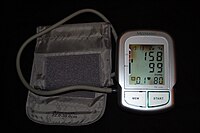
Photo from wikipedia
Among individuals with hypertension, the prevalence of secondary hypertension has been reported to be ≈10%. More than half of individuals with secondary hypertension have associated hyperaldosteronism. However, given the current… Click to show full abstract
Among individuals with hypertension, the prevalence of secondary hypertension has been reported to be ≈10%. More than half of individuals with secondary hypertension have associated hyperaldosteronism. However, given the current clinical environment, these patients often remain undiagnosed. We hypothesized that the urinary sodium/potassium ratio (Na/K) could be used as a simple, low-cost method of screening for hyperaldosteronism among individuals with hypertension in primary care and health examination settings. We recruited hypertensive individuals aged 30–69 years old who were not taking any antihypertensive medications from among participants in health examinations. Urinary Na and K were measured using second morning urine samples, and the plasma aldosterone concentration (PAC) was also measured. We evaluated the association of the second morning urine Na/K ratio (SMU Na/K) with a high PAC, defined as ≥90th percentile (24.3 ng/dL), using receiver operating characteristic (ROC) curves. Overall, 160 participants (108 men and 52 women) with a mean age of 54.3 years were eligible for this study. The area under the ROC curve for the relationship between SMU Na/K and high PAC was 0.77 (95% confidence interval [CI]: 0.59–0.95) in men and 0.64 (95% CI: 0.36–0.93) in women. In men, SMU Na/K values <1.0 could detect hyperaldosteronism with a sensitivity of 45.5%, a specificity of 97.9%, a positive predictive value of 71.4%, and a negative predictive value of 94.1%. The use of the urinary Na/K ratio may be appropriate as a method of screening for hyperaldosteronism in hypertensive men.
Journal Title: Hypertension Research
Year Published: 2021
Link to full text (if available)
Share on Social Media: Sign Up to like & get
recommendations!